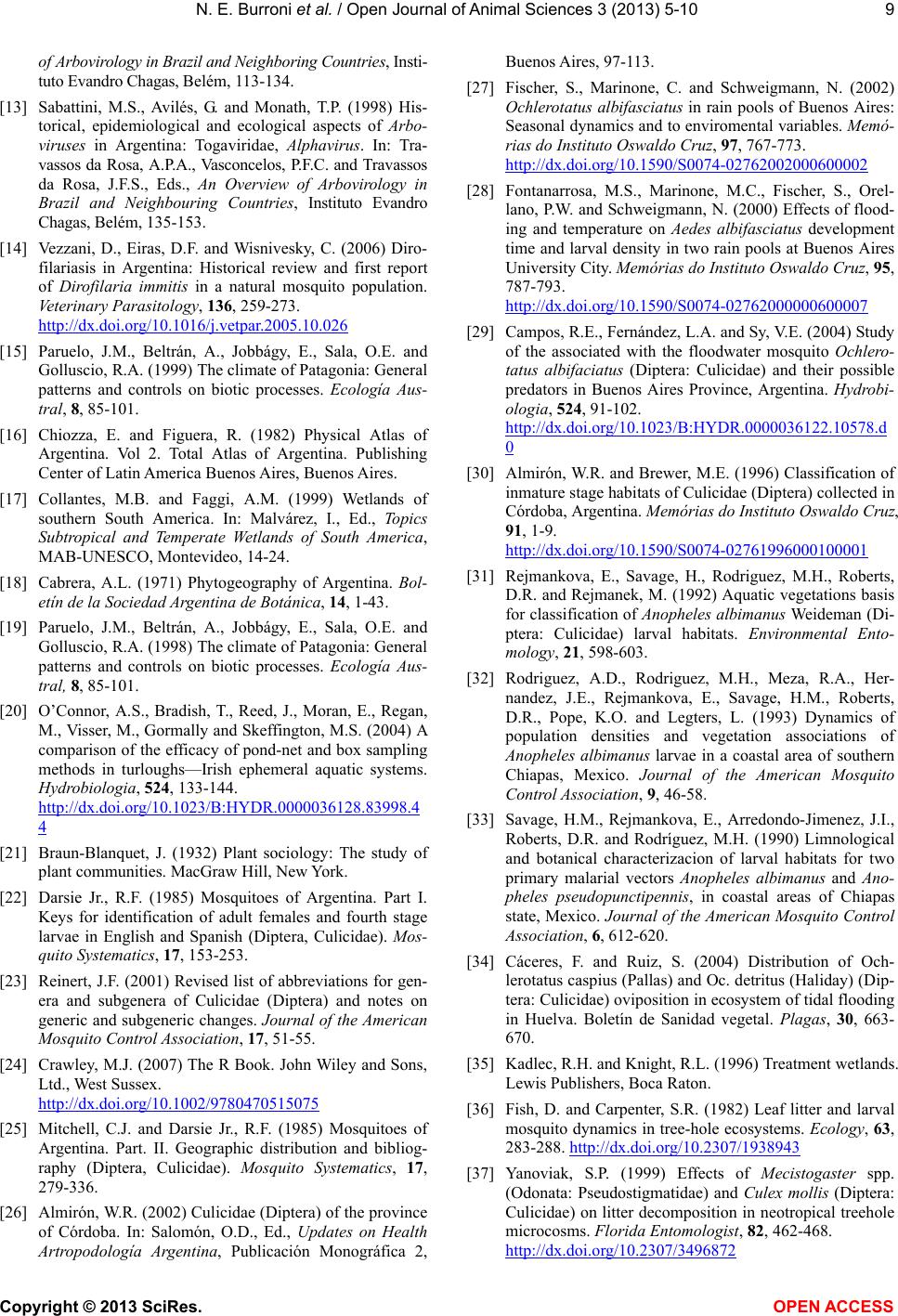
N. E. Burroni et al. / Open Journal of Animal Sciences 3 (2013) 5-10 9
of Arbovirology in Brazil and Neighboring Countries, Insti-
tuto Evandro Chagas, Belém, 113-134.
[13] Sabattini, M.S., Avilés, G. and Monath, T.P. (1998) His-
torical, epidemiological and ecological aspects of Arbo-
viruses in Argentina: Togaviridae, Alphavirus. In: Tra-
vassos da Rosa, A.P.A., Vasconcelos, P.F.C. and Travassos
da Rosa, J.F.S., Eds., An Overview of Arbovirology in
Brazil and Neighbouring Countries, Instituto Evandro
Chagas, Belém, 135-153.
[14] Vezzani, D., Eiras, D.F. and Wisnivesky, C. (2006) Diro-
filariasis in Argentina: Historical review and first report
of Dirofilaria immitis in a natural mosquito population.
Veterinary Parasitology, 136, 259-273.
http://dx.doi.org/10.1016/j.vetpar.2005.10.026
[15] Paruelo, J.M., Beltrán, A., Jobbágy, E., Sala, O.E. and
Golluscio, R.A. (1999) The climate of Patagonia: General
patterns and controls on biotic processes. Ecología Aus-
tral, 8, 85-101.
[16] Chiozza, E. and Figuera, R. (1982) Physical Atlas of
Argentina. Vol 2. Total Atlas of Argentina. Publishing
Center of Latin America Buenos Aires, Buenos Aires.
[17] Collantes, M.B. and Faggi, A.M. (1999) Wetlands of
southern South America. In: Malvárez, I., Ed., Topics
Subtropical and Temperate Wetlands of South America,
MAB-UNESCO, Montevideo, 14-24.
[18] Cabrera, A.L. (1971) Phytogeography of Argentina. Bol-
etín de la Sociedad Argentina de Botánica, 14, 1-43.
[19] Paruelo, J.M., Beltrán, A., Jobbágy, E., Sala, O.E. and
Golluscio, R.A. (1998) The climate of Patagonia: General
patterns and controls on biotic processes. Ecología Aus-
tral, 8, 85-101.
[20] O’Connor, A.S., Bradish, T., Reed, J., Moran, E., Regan,
M., Visser, M., Gormally and Skeffington, M.S. (2004) A
comparison of the efficacy of pond-net and box sampling
methods in turloughs—Irish ephemeral aquatic systems.
Hydrobiologia, 524, 133-144.
http://dx.doi.org/10.1023/B:HYDR.0000036128.83998.4
4
[21] Braun-Blanquet, J. (1932) Plant sociology: The study of
plant communities. MacGraw Hill, New York.
[22] Darsie Jr., R.F. (1985) Mosquitoes of Argentina. Part I.
Keys for identification of adult females and fourth stage
larvae in English and Spanish (Diptera, Culicidae). Mos-
quito Systematics, 17, 153-253.
[23] Reinert, J.F. (2001) Revised list of abbreviations for gen-
era and subgenera of Culicidae (Diptera) and notes on
generic and subgeneric changes. Journal of the American
Mosquito Control Association, 17, 51-55.
[24] Crawley, M.J. (2007) The R Book. John Wiley and Sons,
Ltd., West Sussex.
http://dx.doi.org/10.1002/9780470515075
[25] Mitchell, C.J. and Darsie Jr., R.F. (1985) Mosquitoes of
Argentina. Part. II. Geographic distribution and bibliog-
raphy (Diptera, Culicidae). Mosquito Systematics, 17,
279-336.
[26] Almirón, W.R. (2002) Culicidae (Diptera) of the province
of Córdoba. In: Salomón, O.D., Ed., Updates on Health
Artropodología Argentina, Publicación Monográfica 2,
Buenos Aires, 97-113.
[27] Fischer, S., Marinone, C. and Schweigmann, N. (2002)
Ochlerotatus albifasciatus in rain pools of Buenos Aires:
Seasonal dynamics and to enviromental variables. Memó-
rias do Instituto Oswaldo Cruz, 97, 767-773.
http://dx.doi.org/10.1590/S0074-02762002000600002
[28] Fontanarrosa, M.S., Marinone, M.C., Fischer, S., Orel-
lano, P.W. and Schweigmann, N. (2000) Effects of flood-
ing and temperature on Aedes albifasciatus development
time and larval density in two rain pools at Buenos Aires
University City. Memórias do Instituto Oswaldo Cruz, 95,
787-793.
http://dx.doi.org/10.1590/S0074-02762000000600007
[29] Campos, R.E., Fernández, L.A. and Sy, V.E. (2004) Study
of the associated with the floodwater mosquito Ochlero-
tatus albifaciatus (Diptera: Culicidae) and their possible
predators in Buenos Aires Province, Argentina. Hydrobi-
ologia, 524, 91-102.
http://dx.doi.org/10.1023/B:HYDR.0000036122.10578.d
0
[30] Almirón, W.R. and Brewer, M.E. (1996) Classification of
inmature stage habitats of Culicidae (Diptera) collected in
Córdoba, Argentina. Memórias do Instituto Oswaldo Cruz,
91, 1-9.
http://dx.doi.org/10.1590/S0074-02761996000100001
[31] Rejmankova, E., Savage, H., Rodriguez, M.H., Roberts,
D.R. and Rejmanek, M. (1992) Aquatic vegetations basis
for classification of Anopheles albimanus Weideman (Di-
ptera: Culicidae) larval habitats. Environmental Ento-
mology, 21, 598-603.
[32] Rodriguez, A.D., Rodriguez, M.H., Meza, R.A., Her-
nandez, J.E., Rejmankova, E., Savage, H.M., Roberts,
D.R., Pope, K.O. and Legters, L. (1993) Dynamics of
population densities and vegetation associations of
Anopheles albimanus larvae in a coastal area of southern
Chiapas, Mexico. Journal of the American Mosquito
Control Association, 9, 46-58.
[33] Savage, H.M., Rejmankova, E., Arredondo-Jimenez, J.I.,
Roberts, D.R. and Rodríguez, M.H. (1990) Limnological
and botanical characterizacion of larval habitats for two
primary malarial vectors Anopheles albimanus and Ano-
pheles pseudopunctipennis, in coastal areas of Chiapas
state, Mexico. Journal of the American Mosquito Control
Association, 6, 612-620.
[34] Cáceres, F. and Ruiz, S. (2004) Distribution of Och-
lerotatus caspius (Pallas) and Oc. detritus (Haliday) (Dip-
tera: Culicidae) oviposition in ecosystem of tidal flooding
in Huelva. Boletín de Sanidad vegetal. Plagas, 30, 663-
670.
[35] Kadlec, R.H. and Knight, R.L. (1996) Treatment wetlands.
Lewis Publishers, Boca Raton.
[36] Fish, D. and Carpenter, S.R. (1982) Leaf litter and larval
mosquito dynamics in tree-hole ecosystems. Ecology, 63,
283-288. http://dx.doi.org/10.2307/1938943
[37] Yanoviak, S.P. (1999) Effects of Mecistogaster spp.
(Odonata: Pseudostigmatidae) and Culex mollis (Diptera:
Culicidae) on litter decomposition in neotropical treehole
microcosms. Florida Entomologist, 82, 462-468.
http://dx.doi.org/10.2307/3496872
Copyright © 2013 SciRes. OPEN A CCESS